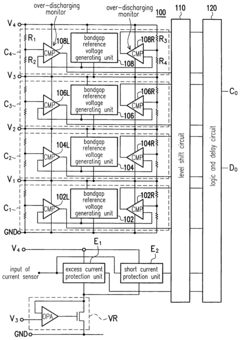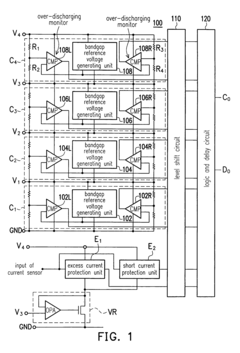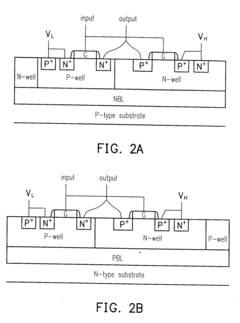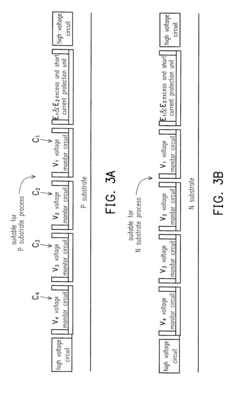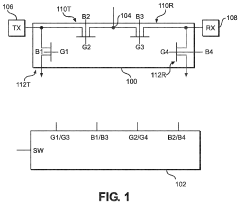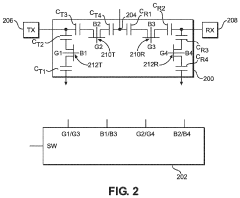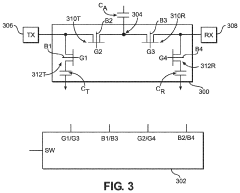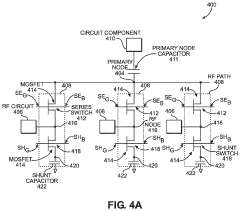How CMOS Battery Shapes Transformative Connectivity Policies?
JUL 22, 202510 MIN READ
Generate Your Research Report Instantly with AI Agent
Patsnap Eureka helps you evaluate technical feasibility & market potential.
CMOS Battery Evolution
The evolution of CMOS battery technology has played a pivotal role in shaping transformative connectivity policies. Initially developed in the 1960s, Complementary Metal-Oxide-Semiconductor (CMOS) batteries have undergone significant advancements, revolutionizing the landscape of portable electronics and connectivity solutions.
In the early stages, CMOS batteries were primarily used to maintain basic system settings and real-time clock functions in computers. However, as technology progressed, their applications expanded to encompass a wide range of devices, including smartphones, wearables, and IoT sensors. This expansion has been instrumental in driving the development of more robust and efficient connectivity policies.
The miniaturization of CMOS batteries has been a key factor in their evolution. As devices became smaller and more portable, the demand for compact power sources increased. This led to the development of thin-film CMOS batteries, which offered improved energy density and flexibility. These advancements enabled the creation of ultra-thin, wearable devices and implantable medical sensors, pushing the boundaries of connectivity in healthcare and personal technology.
Another significant milestone in CMOS battery evolution was the integration of energy harvesting capabilities. This innovation allowed devices to supplement their power needs by capturing energy from the environment, such as light, heat, or motion. The combination of CMOS batteries with energy harvesting technologies has been crucial in extending the operational life of IoT devices and sensors, facilitating the implementation of large-scale, low-maintenance connectivity networks.
The improvement in CMOS battery lifespan and reliability has been instrumental in shaping connectivity policies. As batteries became more durable and long-lasting, it became feasible to deploy sensors and devices in remote or hard-to-reach locations. This capability has been particularly impactful in areas such as environmental monitoring, agriculture, and infrastructure management, where continuous, uninterrupted connectivity is essential.
The evolution of CMOS batteries has also influenced the development of low-power communication protocols. As battery technology improved, it became possible to design more energy-efficient connectivity solutions. This led to the creation of protocols like Bluetooth Low Energy (BLE) and LoRaWAN, which are optimized for long battery life in IoT applications. These advancements have been crucial in enabling the widespread adoption of connected devices and the implementation of smart city initiatives.
Furthermore, the progress in CMOS battery technology has contributed to the development of more sustainable connectivity policies. The increased efficiency and longevity of these batteries have reduced the need for frequent replacements, minimizing electronic waste and environmental impact. This aspect has become increasingly important as governments and organizations worldwide push for more sustainable technological solutions.
In the early stages, CMOS batteries were primarily used to maintain basic system settings and real-time clock functions in computers. However, as technology progressed, their applications expanded to encompass a wide range of devices, including smartphones, wearables, and IoT sensors. This expansion has been instrumental in driving the development of more robust and efficient connectivity policies.
The miniaturization of CMOS batteries has been a key factor in their evolution. As devices became smaller and more portable, the demand for compact power sources increased. This led to the development of thin-film CMOS batteries, which offered improved energy density and flexibility. These advancements enabled the creation of ultra-thin, wearable devices and implantable medical sensors, pushing the boundaries of connectivity in healthcare and personal technology.
Another significant milestone in CMOS battery evolution was the integration of energy harvesting capabilities. This innovation allowed devices to supplement their power needs by capturing energy from the environment, such as light, heat, or motion. The combination of CMOS batteries with energy harvesting technologies has been crucial in extending the operational life of IoT devices and sensors, facilitating the implementation of large-scale, low-maintenance connectivity networks.
The improvement in CMOS battery lifespan and reliability has been instrumental in shaping connectivity policies. As batteries became more durable and long-lasting, it became feasible to deploy sensors and devices in remote or hard-to-reach locations. This capability has been particularly impactful in areas such as environmental monitoring, agriculture, and infrastructure management, where continuous, uninterrupted connectivity is essential.
The evolution of CMOS batteries has also influenced the development of low-power communication protocols. As battery technology improved, it became possible to design more energy-efficient connectivity solutions. This led to the creation of protocols like Bluetooth Low Energy (BLE) and LoRaWAN, which are optimized for long battery life in IoT applications. These advancements have been crucial in enabling the widespread adoption of connected devices and the implementation of smart city initiatives.
Furthermore, the progress in CMOS battery technology has contributed to the development of more sustainable connectivity policies. The increased efficiency and longevity of these batteries have reduced the need for frequent replacements, minimizing electronic waste and environmental impact. This aspect has become increasingly important as governments and organizations worldwide push for more sustainable technological solutions.
Connectivity Market Trends
The connectivity market is experiencing rapid growth and transformation, driven by the increasing demand for seamless and ubiquitous connectivity across various industries and consumer segments. This trend is particularly evident in the Internet of Things (IoT) sector, where the number of connected devices is projected to reach 30.9 billion by 2025. The proliferation of smart homes, industrial automation, and connected vehicles is fueling this growth, creating new opportunities for connectivity providers and technology companies.
5G technology is playing a pivotal role in shaping the connectivity landscape. With its promise of ultra-low latency, high bandwidth, and massive device connectivity, 5G is enabling new use cases and applications that were previously unfeasible. The global 5G market is expected to grow at a CAGR of 43.9% from 2021 to 2027, reaching a market value of $667.90 billion by 2027. This rapid adoption is driving investments in network infrastructure and spurring innovation in edge computing and network slicing technologies.
The enterprise segment is emerging as a key driver of connectivity market growth. Businesses are increasingly adopting digital transformation strategies, leading to a surge in demand for advanced connectivity solutions. Cloud computing, artificial intelligence, and big data analytics are pushing the boundaries of what's possible with connected systems, creating a need for more robust and flexible connectivity options. This trend is particularly pronounced in industries such as manufacturing, healthcare, and finance, where real-time data processing and analysis are critical for operational efficiency and competitive advantage.
In the consumer space, the rise of streaming services, online gaming, and remote work has led to an increased demand for high-speed broadband and mobile connectivity. Fixed wireless access (FWA) is gaining traction as an alternative to traditional fixed-line broadband, especially in underserved areas. The global FWA market is projected to grow at a CAGR of 99.3% from 2019 to 2025, reaching $46.69 billion by 2025.
Satellite internet is another emerging trend in the connectivity market, with companies like SpaceX's Starlink and Amazon's Project Kuiper aiming to provide global broadband coverage through low Earth orbit (LEO) satellite constellations. This technology has the potential to bridge the digital divide by bringing high-speed internet to remote and rural areas that are currently underserved by terrestrial networks.
The increasing importance of connectivity is also driving innovation in energy-efficient technologies and power management solutions. As the number of connected devices grows, so does the need for sustainable power sources and long-lasting batteries. This is where CMOS battery technology comes into play, offering low-power consumption and extended life cycles for IoT devices and sensors. The development of advanced CMOS batteries is crucial for enabling the deployment of large-scale IoT networks and supporting the long-term viability of connected ecosystems.
5G technology is playing a pivotal role in shaping the connectivity landscape. With its promise of ultra-low latency, high bandwidth, and massive device connectivity, 5G is enabling new use cases and applications that were previously unfeasible. The global 5G market is expected to grow at a CAGR of 43.9% from 2021 to 2027, reaching a market value of $667.90 billion by 2027. This rapid adoption is driving investments in network infrastructure and spurring innovation in edge computing and network slicing technologies.
The enterprise segment is emerging as a key driver of connectivity market growth. Businesses are increasingly adopting digital transformation strategies, leading to a surge in demand for advanced connectivity solutions. Cloud computing, artificial intelligence, and big data analytics are pushing the boundaries of what's possible with connected systems, creating a need for more robust and flexible connectivity options. This trend is particularly pronounced in industries such as manufacturing, healthcare, and finance, where real-time data processing and analysis are critical for operational efficiency and competitive advantage.
In the consumer space, the rise of streaming services, online gaming, and remote work has led to an increased demand for high-speed broadband and mobile connectivity. Fixed wireless access (FWA) is gaining traction as an alternative to traditional fixed-line broadband, especially in underserved areas. The global FWA market is projected to grow at a CAGR of 99.3% from 2019 to 2025, reaching $46.69 billion by 2025.
Satellite internet is another emerging trend in the connectivity market, with companies like SpaceX's Starlink and Amazon's Project Kuiper aiming to provide global broadband coverage through low Earth orbit (LEO) satellite constellations. This technology has the potential to bridge the digital divide by bringing high-speed internet to remote and rural areas that are currently underserved by terrestrial networks.
The increasing importance of connectivity is also driving innovation in energy-efficient technologies and power management solutions. As the number of connected devices grows, so does the need for sustainable power sources and long-lasting batteries. This is where CMOS battery technology comes into play, offering low-power consumption and extended life cycles for IoT devices and sensors. The development of advanced CMOS batteries is crucial for enabling the deployment of large-scale IoT networks and supporting the long-term viability of connected ecosystems.
CMOS Power Challenges
CMOS (Complementary Metal-Oxide-Semiconductor) technology has been a cornerstone in the development of modern electronic devices, particularly in the realm of connectivity. However, as the demand for more powerful and energy-efficient devices continues to grow, CMOS technology faces significant power challenges that need to be addressed to shape transformative connectivity policies.
One of the primary power challenges in CMOS technology is static power consumption, also known as leakage power. As transistor sizes continue to shrink, the gate oxide thickness decreases, leading to increased subthreshold leakage and gate oxide tunneling. This results in higher standby power consumption, which is particularly problematic for battery-powered devices and always-on connectivity applications.
Dynamic power consumption presents another significant challenge. As clock frequencies increase and more transistors are packed into smaller areas, the power consumed during switching operations rises dramatically. This not only impacts battery life but also creates thermal management issues, potentially affecting device reliability and performance.
The power density problem is becoming increasingly critical as we push the boundaries of CMOS scaling. With more transistors per unit area, the power dissipation per unit area increases, leading to hotspots and thermal runaway risks. This challenge is particularly acute in high-performance computing and data center applications, where connectivity and processing demands are at their peak.
Voltage scaling, once a reliable method for reducing power consumption, is reaching its limits. As supply voltages approach the threshold voltage of transistors, further reduction becomes difficult without compromising performance and reliability. This limitation hinders the development of ultra-low-power devices crucial for the Internet of Things (IoT) and edge computing applications.
The increasing complexity of modern System-on-Chip (SoC) designs exacerbates power management challenges. Integrating diverse components such as processors, memory, and connectivity modules on a single chip requires sophisticated power gating and dynamic voltage and frequency scaling (DVFS) techniques. Balancing performance and power efficiency across these heterogeneous components is a complex task that directly impacts connectivity capabilities.
Furthermore, the rise of artificial intelligence and machine learning applications in edge devices puts additional strain on CMOS power efficiency. These computationally intensive tasks demand high performance while maintaining low power consumption, pushing the limits of current CMOS technology.
Addressing these power challenges is crucial for shaping transformative connectivity policies. Innovations in CMOS technology, such as FinFET and Gate-All-Around (GAA) transistors, offer promising solutions but also introduce new complexities in power management. The development of new materials and novel device architectures, like carbon nanotubes or 2D materials, may provide pathways to overcome current limitations.
One of the primary power challenges in CMOS technology is static power consumption, also known as leakage power. As transistor sizes continue to shrink, the gate oxide thickness decreases, leading to increased subthreshold leakage and gate oxide tunneling. This results in higher standby power consumption, which is particularly problematic for battery-powered devices and always-on connectivity applications.
Dynamic power consumption presents another significant challenge. As clock frequencies increase and more transistors are packed into smaller areas, the power consumed during switching operations rises dramatically. This not only impacts battery life but also creates thermal management issues, potentially affecting device reliability and performance.
The power density problem is becoming increasingly critical as we push the boundaries of CMOS scaling. With more transistors per unit area, the power dissipation per unit area increases, leading to hotspots and thermal runaway risks. This challenge is particularly acute in high-performance computing and data center applications, where connectivity and processing demands are at their peak.
Voltage scaling, once a reliable method for reducing power consumption, is reaching its limits. As supply voltages approach the threshold voltage of transistors, further reduction becomes difficult without compromising performance and reliability. This limitation hinders the development of ultra-low-power devices crucial for the Internet of Things (IoT) and edge computing applications.
The increasing complexity of modern System-on-Chip (SoC) designs exacerbates power management challenges. Integrating diverse components such as processors, memory, and connectivity modules on a single chip requires sophisticated power gating and dynamic voltage and frequency scaling (DVFS) techniques. Balancing performance and power efficiency across these heterogeneous components is a complex task that directly impacts connectivity capabilities.
Furthermore, the rise of artificial intelligence and machine learning applications in edge devices puts additional strain on CMOS power efficiency. These computationally intensive tasks demand high performance while maintaining low power consumption, pushing the limits of current CMOS technology.
Addressing these power challenges is crucial for shaping transformative connectivity policies. Innovations in CMOS technology, such as FinFET and Gate-All-Around (GAA) transistors, offer promising solutions but also introduce new complexities in power management. The development of new materials and novel device architectures, like carbon nanotubes or 2D materials, may provide pathways to overcome current limitations.
Current CMOS Solutions
01 CMOS battery connection and power management
CMOS batteries are crucial for maintaining system settings and real-time clock functions in computers. Proper connectivity and power management techniques ensure reliable operation and extended battery life. This includes implementing efficient charging circuits, voltage regulation, and power-saving modes.- CMOS battery connection and power management: CMOS batteries are crucial for maintaining system settings and real-time clock functions in computers. Proper connectivity ensures uninterrupted power supply to the CMOS chip, preserving critical data when the main power is off. Advanced power management techniques can optimize battery life and improve overall system reliability.
- Battery monitoring and fault detection: Implementing battery monitoring systems can help detect issues with CMOS battery connectivity. These systems can measure voltage levels, predict battery life, and alert users to potential failures. Fault detection mechanisms ensure timely replacement of batteries, preventing data loss and system malfunctions.
- CMOS battery backup systems: Backup systems for CMOS batteries provide an additional layer of protection against data loss. These systems may include secondary batteries, capacitors, or alternative power sources that can temporarily maintain CMOS memory when the primary battery fails or is disconnected. This ensures continuous operation and data integrity.
- CMOS battery connection design and layout: The physical design and layout of CMOS battery connections play a crucial role in ensuring reliable power delivery. Considerations include connector type, placement on the motherboard, and protection against environmental factors. Proper design can minimize the risk of accidental disconnection and improve overall system durability.
- Integration of CMOS battery with system-on-chip designs: As electronic devices become more compact, integrating CMOS battery connectivity into system-on-chip (SoC) designs is becoming increasingly important. This integration can lead to more efficient power management, reduced board space, and improved overall system performance. Challenges include managing power distribution and ensuring proper isolation between components.
02 Battery monitoring and fault detection
Systems for monitoring CMOS battery status, detecting faults, and providing alerts are essential for maintaining system integrity. These may include voltage monitoring circuits, current sensors, and software-based diagnostics to identify potential issues before they lead to system failures.Expand Specific Solutions03 CMOS battery backup and data retention
Techniques for ensuring data retention during main power loss or battery replacement are critical. This involves implementing backup power sources, capacitor-based solutions, or non-volatile memory to preserve system settings and critical data when the CMOS battery is disconnected or depleted.Expand Specific Solutions04 CMOS battery interface and connectivity solutions
Innovative designs for CMOS battery interfaces and connectors improve reliability and ease of maintenance. This includes developing secure connection mechanisms, standardized interfaces, and modular designs that facilitate easy battery replacement without risking damage to the motherboard or loss of data.Expand Specific Solutions05 Integration of CMOS battery with system-on-chip designs
As electronic systems become more integrated, there's a trend towards incorporating CMOS battery management functions directly into system-on-chip (SoC) designs. This approach can improve efficiency, reduce component count, and enhance overall system reliability by tightly coupling battery management with other core system functions.Expand Specific Solutions
Key Industry Players
The CMOS battery connectivity landscape is in a mature phase, with established players dominating the market. The global market size for CMOS batteries is substantial, driven by the ubiquity of electronic devices requiring persistent memory. Technologically, the field is well-developed, with companies like Texas Instruments, IBM, and Cisco leading innovation. Samsung SDI and Panasonic are key players in battery technology, while NXP Semiconductors and SK hynix contribute to semiconductor advancements. TSMC and Qualcomm are pushing boundaries in chip manufacturing and wireless technologies, respectively. The competitive landscape is characterized by incremental improvements rather than disruptive innovations, with a focus on enhancing efficiency, longevity, and integration with emerging technologies.
Texas Instruments Incorporated
Technical Solution: Texas Instruments (TI) has developed advanced CMOS battery management solutions that shape transformative connectivity policies. Their BQ76952 battery monitor and protector IC integrates high-accuracy voltage and current measurement with sophisticated battery protection and balancing algorithms[1]. This IC supports up to 16-series cell configurations and includes a built-in high-voltage multiplexer, precision analog-to-digital converter, and an embedded ARM Cortex-M0+ microcontroller for local control and diagnostics[2]. TI's solution enables real-time monitoring and adaptive control of battery systems, crucial for maintaining optimal performance and longevity in connected devices and electric vehicles.
Strengths: High integration level, advanced protection features, and scalability for various battery configurations. Weaknesses: May require additional components for complete system implementation, potentially increasing overall cost and complexity.
Cisco Technology, Inc.
Technical Solution: Cisco has developed innovative solutions that leverage CMOS battery technology to enhance network connectivity and power management. Their Meraki cloud-managed devices utilize low-power CMOS designs and intelligent battery backup systems to ensure uninterrupted connectivity[3]. Cisco's Power over Ethernet (PoE) switches incorporate advanced power management features that optimize CMOS battery usage in connected devices, enabling more efficient and reliable network infrastructures[4]. Additionally, Cisco's IoT solutions integrate CMOS-based sensors with long-lasting battery life, facilitating extended deployment of connected devices in remote or challenging environments without frequent maintenance[5].
Strengths: Comprehensive ecosystem of network devices with integrated power management, cloud-based management capabilities. Weaknesses: Dependency on proprietary technologies may limit interoperability with third-party systems.
Innovative Power Designs
Complementary metal oxide semiconductor structure for battery protection circuit and battery protection circuit having the same
PatentInactiveUS20050052802A1
Innovation
- The implementation of a CMOS structure using tri-well or buried layer techniques allows for a battery protection circuit that operates at relatively low voltage, isolates substrate noise, and includes overcharging and over-discharging units, excess current protection, and short circuit protection, utilizing NMOS and PMOS transistors with specific voltage configurations and a bandgap reference voltage-generating unit to monitor and regulate battery voltage and current.
Complementary metal-oxide semiconductor (CMOS) compatible RF switch and high voltage control circuit (HVCC)
PatentActiveUS20210050846A1
Innovation
- A CMOS-compatible RF switch circuit with a high voltage control circuit (HVCC) that uses standard CMOS logic circuits to supply high and low voltage signals to MOSFET switches, eliminating the need for charge pumps and capacitors by employing a medial voltage between the power supply and reference voltage to fully turn on and off the switches.
Regulatory Compliance
The regulatory landscape surrounding CMOS battery technology and its impact on connectivity policies is complex and evolving. As CMOS batteries play an increasingly crucial role in powering various electronic devices and systems, regulatory bodies worldwide are adapting their frameworks to address the associated challenges and opportunities.
Compliance with electromagnetic compatibility (EMC) regulations is a primary concern for manufacturers utilizing CMOS batteries. These regulations aim to ensure that electronic devices do not interfere with other equipment or cause electromagnetic disturbances. As CMOS batteries become more prevalent in connected devices, regulatory bodies are refining EMC standards to account for their unique characteristics and potential impacts on wireless communications.
Safety regulations also play a significant role in shaping the use of CMOS batteries in connectivity applications. Regulatory agencies such as the Federal Communications Commission (FCC) in the United States and the European Union's CE marking system have established guidelines for battery safety, including requirements for protection against overcharging, short circuits, and thermal runaway. Manufacturers must demonstrate compliance with these safety standards to bring their CMOS battery-powered devices to market.
Environmental regulations are another critical aspect of CMOS battery compliance. Many jurisdictions have implemented strict rules governing the disposal and recycling of batteries, including CMOS batteries. The European Union's Battery Directive, for instance, sets targets for battery collection and recycling rates, as well as restrictions on the use of certain hazardous substances in battery manufacturing. These regulations are driving innovation in CMOS battery design, encouraging the development of more environmentally friendly and recyclable solutions.
Data privacy and security regulations are increasingly intersecting with CMOS battery technology, particularly in the context of Internet of Things (IoT) devices. As CMOS batteries enable longer operational lifetimes for connected devices, regulators are focusing on ensuring that these devices maintain data protection and security standards throughout their extended use. This includes requirements for secure firmware updates, data encryption, and protection against unauthorized access.
The global nature of technology supply chains necessitates a harmonized approach to regulatory compliance. International standards organizations, such as the International Electrotechnical Commission (IEC) and the Institute of Electrical and Electronics Engineers (IEEE), are working to develop unified standards for CMOS battery technology and its applications in connectivity. These efforts aim to streamline compliance processes and reduce barriers to global market entry for manufacturers.
As CMOS battery technology continues to advance, regulatory frameworks are likely to evolve in tandem. Future regulations may address emerging concerns such as the integration of CMOS batteries with energy harvesting technologies, the use of artificial intelligence in battery management systems, and the potential health impacts of long-term exposure to low-level electromagnetic fields from battery-powered devices. Manufacturers and policymakers must remain vigilant and adaptable to ensure that regulatory compliance keeps pace with technological innovation in this rapidly changing field.
Compliance with electromagnetic compatibility (EMC) regulations is a primary concern for manufacturers utilizing CMOS batteries. These regulations aim to ensure that electronic devices do not interfere with other equipment or cause electromagnetic disturbances. As CMOS batteries become more prevalent in connected devices, regulatory bodies are refining EMC standards to account for their unique characteristics and potential impacts on wireless communications.
Safety regulations also play a significant role in shaping the use of CMOS batteries in connectivity applications. Regulatory agencies such as the Federal Communications Commission (FCC) in the United States and the European Union's CE marking system have established guidelines for battery safety, including requirements for protection against overcharging, short circuits, and thermal runaway. Manufacturers must demonstrate compliance with these safety standards to bring their CMOS battery-powered devices to market.
Environmental regulations are another critical aspect of CMOS battery compliance. Many jurisdictions have implemented strict rules governing the disposal and recycling of batteries, including CMOS batteries. The European Union's Battery Directive, for instance, sets targets for battery collection and recycling rates, as well as restrictions on the use of certain hazardous substances in battery manufacturing. These regulations are driving innovation in CMOS battery design, encouraging the development of more environmentally friendly and recyclable solutions.
Data privacy and security regulations are increasingly intersecting with CMOS battery technology, particularly in the context of Internet of Things (IoT) devices. As CMOS batteries enable longer operational lifetimes for connected devices, regulators are focusing on ensuring that these devices maintain data protection and security standards throughout their extended use. This includes requirements for secure firmware updates, data encryption, and protection against unauthorized access.
The global nature of technology supply chains necessitates a harmonized approach to regulatory compliance. International standards organizations, such as the International Electrotechnical Commission (IEC) and the Institute of Electrical and Electronics Engineers (IEEE), are working to develop unified standards for CMOS battery technology and its applications in connectivity. These efforts aim to streamline compliance processes and reduce barriers to global market entry for manufacturers.
As CMOS battery technology continues to advance, regulatory frameworks are likely to evolve in tandem. Future regulations may address emerging concerns such as the integration of CMOS batteries with energy harvesting technologies, the use of artificial intelligence in battery management systems, and the potential health impacts of long-term exposure to low-level electromagnetic fields from battery-powered devices. Manufacturers and policymakers must remain vigilant and adaptable to ensure that regulatory compliance keeps pace with technological innovation in this rapidly changing field.
Environmental Impact
The environmental impact of CMOS batteries in shaping transformative connectivity policies is a critical consideration in the evolving landscape of technology and sustainability. These small but essential components play a significant role in maintaining system configurations and real-time clocks in various electronic devices, including those central to connectivity infrastructure.
The production of CMOS batteries involves the extraction and processing of raw materials, primarily lithium, which has notable environmental implications. Mining activities for lithium can lead to soil degradation, water pollution, and habitat disruption in extraction areas. Furthermore, the manufacturing process of these batteries contributes to carbon emissions and energy consumption, adding to the overall environmental footprint of electronic devices.
As connectivity policies evolve to accommodate the growing demand for always-on, interconnected systems, the reliance on CMOS batteries increases. This trend raises concerns about the long-term sustainability of these components, particularly in terms of resource depletion and waste management. The disposal of CMOS batteries at the end of their lifecycle presents another environmental challenge, as improper handling can lead to soil and water contamination due to the leaching of toxic materials.
However, the role of CMOS batteries in enabling energy-efficient standby modes and maintaining system integrity during power-off states contributes to overall energy conservation in electronic devices. This aspect aligns with broader environmental goals of reducing power consumption and extending device lifespan, potentially offsetting some of the negative impacts associated with their production and disposal.
The environmental considerations surrounding CMOS batteries are driving innovation in connectivity policies and technologies. There is a growing focus on developing more sustainable alternatives, such as non-volatile memory solutions that could reduce or eliminate the need for traditional CMOS batteries. Additionally, policies are being shaped to encourage the use of more environmentally friendly materials in battery production and to improve recycling and disposal practices for electronic components.
As transformative connectivity policies continue to evolve, they increasingly incorporate environmental sustainability as a key factor. This includes promoting the development of low-power connectivity solutions, extending the lifespan of devices to reduce electronic waste, and implementing stricter regulations on the production and disposal of electronic components like CMOS batteries. These policies aim to balance the need for advanced connectivity with the imperative of environmental protection, recognizing the interconnected nature of technological progress and ecological responsibility.
The production of CMOS batteries involves the extraction and processing of raw materials, primarily lithium, which has notable environmental implications. Mining activities for lithium can lead to soil degradation, water pollution, and habitat disruption in extraction areas. Furthermore, the manufacturing process of these batteries contributes to carbon emissions and energy consumption, adding to the overall environmental footprint of electronic devices.
As connectivity policies evolve to accommodate the growing demand for always-on, interconnected systems, the reliance on CMOS batteries increases. This trend raises concerns about the long-term sustainability of these components, particularly in terms of resource depletion and waste management. The disposal of CMOS batteries at the end of their lifecycle presents another environmental challenge, as improper handling can lead to soil and water contamination due to the leaching of toxic materials.
However, the role of CMOS batteries in enabling energy-efficient standby modes and maintaining system integrity during power-off states contributes to overall energy conservation in electronic devices. This aspect aligns with broader environmental goals of reducing power consumption and extending device lifespan, potentially offsetting some of the negative impacts associated with their production and disposal.
The environmental considerations surrounding CMOS batteries are driving innovation in connectivity policies and technologies. There is a growing focus on developing more sustainable alternatives, such as non-volatile memory solutions that could reduce or eliminate the need for traditional CMOS batteries. Additionally, policies are being shaped to encourage the use of more environmentally friendly materials in battery production and to improve recycling and disposal practices for electronic components.
As transformative connectivity policies continue to evolve, they increasingly incorporate environmental sustainability as a key factor. This includes promoting the development of low-power connectivity solutions, extending the lifespan of devices to reduce electronic waste, and implementing stricter regulations on the production and disposal of electronic components like CMOS batteries. These policies aim to balance the need for advanced connectivity with the imperative of environmental protection, recognizing the interconnected nature of technological progress and ecological responsibility.
Unlock deeper insights with Patsnap Eureka Quick Research — get a full tech report to explore trends and direct your research. Try now!
Generate Your Research Report Instantly with AI Agent
Supercharge your innovation with Patsnap Eureka AI Agent Platform!
